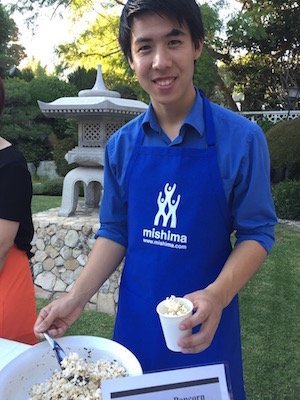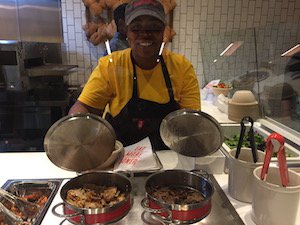 (Gerry Furth-Sides) Surfas takes on teaching families how to create contemporary favorites out of popular Chinese-inspired and Mexican dishes in their new line-up of cooking classes. It is totally in line with the family-like atmosphere at Surfas — which Diane Surfas’ family founded decades ago, and remains a mainstay in Culver City for the amateur and professional alike. The kitchen is under the supervision of Executive Chef Rubina Khan.
(Gerry Furth-Sides) Surfas takes on teaching families how to create contemporary favorites out of popular Chinese-inspired and Mexican dishes in their new line-up of cooking classes. It is totally in line with the family-like atmosphere at Surfas — which Diane Surfas’ family founded decades ago, and remains a mainstay in Culver City for the amateur and professional alike. The kitchen is under the supervision of Executive Chef Rubina Khan.

The staff is not only friendly but knowledgeable, and ready to help. And the well-lighted store with its airy, beamed ceiling always gives the feeling of soaring (rather than warehouse).
 The classes feel like you are a valued guest rather than a student with a number. Not only is there ample seating with a long counter/stove/prep area for the instructor but an overhead mirror — and lots of samples.
The classes feel like you are a valued guest rather than a student with a number. Not only is there ample seating with a long counter/stove/prep area for the instructor but an overhead mirror — and lots of samples.
 The huge store is an experience in itself (conveniently located right off the 10 freeway at Robertson).
The huge store is an experience in itself (conveniently located right off the 10 freeway at Robertson).

From the novel handprints on the sidewalk leading into the store and cafe from the (free) parking lot to the glass-enclosed cooking class area, there is a dazzling array of things to explore.
 Tall shelves are lined with what appears to be very conceivable kitchen product and glass cases along the wall and in one corner feature mouth-watering, esoteric products such as French cheeses and snails.
Tall shelves are lined with what appears to be very conceivable kitchen product and glass cases along the wall and in one corner feature mouth-watering, esoteric products such as French cheeses and snails.

The trick is to have in mind what you are looking for or a limit. It’s easy to buy and buy and buy. I have!

 Another new class is the Mexican Tapas & Sangria night. For us it is the perfect time of the end of a Sunday afternoon to close out the week-end, learn something and be motivated for the coming week and early enough to still relax at home. The drinks give it a special feel.
Another new class is the Mexican Tapas & Sangria night. For us it is the perfect time of the end of a Sunday afternoon to close out the week-end, learn something and be motivated for the coming week and early enough to still relax at home. The drinks give it a special feel. 
Tapas don’t have to be Spanish. This strictly Los Angelino take on quick, easy bites, is also perfect for socializing over a pitcher of Sangria. Surfas chefs show how easy entertaining can be with fresh ingredients and easy-to-prepare recipes.
Pico de Gallo – Fresh tomato, cilantro and onion salsa that pairs well with most dishes
Chili Garlic Shrimp & Avocado Tostada – a surprisingly flavorful, quick party dish
Beer Batter Fish Tacos – Succulent fresh fish battered and fried, served up Baja style
Cilantro Lime Chicken Tacos – Chicken tacos with a twist of tart lime.
Mexican Cole Slaw – A lovely accompaniment to all of the dishes on the menu
Fruity Sangria – The perfect drink, full of juicy fresh fruit, to top it all off 
Mon – Sat 9:00am-6:00pm
Sun – 11:00am-5:00pm
CAFE HOURS
Breakfast
Mon – Sat 8:00am – 11:30am
Sun 10:00am – 11:30am
Lunch
Mon – Sat 11:00am-5:00pm
Sun 11:00am-4:30pm
(Grill closes at 3:00pm every day)
 |
|
8777 W. Washington Blvd
|
Culver City, CA
90232
(310) 559-4770










 (Gerry Furth-Sides) Spices are an excellent introduction to a new ethnic cuisine. Mishima Foods line is one example of how it works. We first encountered the product in the garden of the Los angeles Japanese Consul at the Kompai! film party. The idea here is to show consumers how it can be used on different American (popcorn) and Asian foods.
(Gerry Furth-Sides) Spices are an excellent introduction to a new ethnic cuisine. Mishima Foods line is one example of how it works. We first encountered the product in the garden of the Los angeles Japanese Consul at the Kompai! film party. The idea here is to show consumers how it can be used on different American (popcorn) and Asian foods.












 (Eagle Rock, CA) Guests at the Grand Opening of SpireWorks® Eagle Rock on Tuesday, January 24th, 2017 will be offered a Free SpireWorks® Destination (served on a choice of bread, exotic wild rice or salad), SpireCake andBeverage (choice of Soda or Ice Tea) from 11:00 am to 2:00 pm and 5:00 pm to 8:00 pm.
(Eagle Rock, CA) Guests at the Grand Opening of SpireWorks® Eagle Rock on Tuesday, January 24th, 2017 will be offered a Free SpireWorks® Destination (served on a choice of bread, exotic wild rice or salad), SpireCake andBeverage (choice of Soda or Ice Tea) from 11:00 am to 2:00 pm and 5:00 pm to 8:00 pm.
 The SpireWorks® vision began with two friends in business, SpireWorks® Founder and CEO Bob Kaufman and Chief Operating Officer Jeff Rosenthal.
The SpireWorks® vision began with two friends in business, SpireWorks® Founder and CEO Bob Kaufman and Chief Operating Officer Jeff Rosenthal.





 (Gerry Furth-Sides) Every Wednesday this winter, starting January 18, Il Cortile Ristorante will be offering a ‘Reverse Wine Dinner’ series. Each week, a selected Paso Robles winery is the focus of the dinner with special ingredients imported from Italy.
(Gerry Furth-Sides) Every Wednesday this winter, starting January 18, Il Cortile Ristorante will be offering a ‘Reverse Wine Dinner’ series. Each week, a selected Paso Robles winery is the focus of the dinner with special ingredients imported from Italy.





 (
( Dr. Charles’ recipe is simple, “Boil up water or soup with the iron fish for at least 10 minutes. That enhances the iron which leaches from it,” he directs. “Then take it out. Now add a little lemon juice which is important for the absorption of the iron.”
Dr. Charles’ recipe is simple, “Boil up water or soup with the iron fish for at least 10 minutes. That enhances the iron which leaches from it,” he directs. “Then take it out. Now add a little lemon juice which is important for the absorption of the iron.” (
(





 “We especially enjoyed the spicy and aromatic kitchen of India. There, ancient spices such as cardamom, cumin and red pepper to make this original chickpea curry.
“We especially enjoyed the spicy and aromatic kitchen of India. There, ancient spices such as cardamom, cumin and red pepper to make this original chickpea curry.
 The rub contains only organic, natural ingredients. It is meant to infuse the famous Texas flavor and charred crust on meats whether it is beef or pork or lamb. Brown cane sugar accounts for the crust. We love it and use it on our steaks (all cuts) and even lamb chops and sweet or russet potatoes.
The rub contains only organic, natural ingredients. It is meant to infuse the famous Texas flavor and charred crust on meats whether it is beef or pork or lamb. Brown cane sugar accounts for the crust. We love it and use it on our steaks (all cuts) and even lamb chops and sweet or russet potatoes.
 The combination also includes black pepper, paprika, garlic salt, natural smoke flavor, onion, crushed pink pepper, oregano, earthy cumin, a bold mustard with a bite.
The combination also includes black pepper, paprika, garlic salt, natural smoke flavor, onion, crushed pink pepper, oregano, earthy cumin, a bold mustard with a bite.



 Gerry Furth-Sides
Gerry Furth-Sides  Barbara Hansen
Barbara Hansen  Chef-owner Alain Cohen
Chef-owner Alain Cohen  Roberta Deen
Roberta Deen  Jose Martinez
Jose Martinez  Nivedita Basu
Nivedita Basu